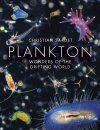About this book
Ask anyone to picture a bird or a fish and a series of clear images will immediately come to mind. Ask the same person to picture plankton and most would have a hard time conjuring anything beyond a vague squiggle or a greyish fleck. Plankton: Wonders of the Drifting World will change that forever.
Viewing these creatures up close for the first time can be a thrilling experience – an elaborate but hidden world truly opens up before your eyes. Through hundreds of close-up photographs, Plankton transports readers into the currents, where jeweled chains hang next to phosphorescent chandeliers, spidery claws jut out from sinuous bodies, and gelatinous barrels protect microscopic hearts. The creatures' vibrant colors pop against the black pages, allowing readers to examine every eye and follow every tentacle. Jellyfish, tadpoles, and bacteria all find a place in Plankton: Wonders of the Drifting World, representing the broad scope of organisms dependent on drifting currents.
Christian Sardet's enlightening text explains the biological underpinnings of each species while connecting them to the larger living world. He begins with plankton's origins and history, then dives into each group, covering ctenophores and cnidarians, crustaceans and mollusks, and worms and tadpoles. He also demonstrates the indisputable impact of plankton in our lives. Plankton drift through our world mostly unseen, yet they are diverse organisms that form ninety-five percent of ocean life. Biologically, they are the foundation of the aquatic food web and consume as much carbon dioxide as land-based plants. Culturally, they have driven new industries and captured artists' imaginations.
While scientists and entrepreneurs are just starting to tap the potential of this undersea forest, for most people these pages will represent uncharted waters. Plankton is a spectacular journey that will leave readers seeing the ocean in ways they never imagined.
Contents
- Prologue, by Mark Ohman
- Introduction. Plankton: Wonders of the Drifting World
- What Are Plankton?
- Plankton and Man
- The Origins: Life Shapes the Planet
- Explosions, Extinctions, and Evolution of Life in the Ocean
- A Chronological History of the Planet and the Tree of Life
- Taxonomy and Phylogeny: Hierarchical Categorizations
- Organisms of All Sizes, with Different Roles and Behavior
- Collecting and Identifying Plankton, Then and Now
- Plankton of the World
- Villefranche-sur-Mer, France: A Bay Famous for Its Plankton
- Between Ecuador and Galapagos: Tara Oceans Expedition
- South Carolina, United States: Salt Marsh Estuaries
- Izu Peninsula and Shimoda, Japan: Autumn Plankton
- Unicellular Creatures: From the Origins of Life
- Bacteria, Archaea, and Viruses: Invisible but Omnipresent
- Unicellular Protists: Precursors of Plants and Animals
- Phytoplankton
- Coccolithophores and Foraminifera: Limestone Architects
- Diatoms and Dinoflagellates: Silicate or Cellulose Houses
- Radiolarians: Polycystines and Acantharians: Symbiosis at the Ocean Surface
- Ciliates, Tintinnids, and Choanoflagellates: Motility and Multicellularity
- Ctenophores and Cnidarians: Ancestral Forms
- Ctenophores: Carnivorous Comb Jellies
- Jellyfish: Equipped to Survive
- Siphonophores: The Longest Animals in the World
- Velella, Porpita, and Physalia: Planktonic Sailors
- Crustaceans and Mollusks: Champions of Diversity
- Crustacean Larvae: Molting and Metamorphosis
- Copepods to Amphipods: Variations on a Theme
- Phronima: Monster in a Barrel
- Pteropods and Heteropods: Mollusks That Swim with Their Feet
- Cephalopods and Nudibranchs: Beautiful Colors and Camouflage
- Worms and Tadpoles: Arrows, Tubes, and Nets
- Chaetognaths: Arrows in the Oceans
- Polychaete Annelids: Worms in the Sea
- Salps, Doliolids, and Pyrosomes: Highly Evolved Gelatinous Animals
- Larvaceans: Tadpoles That Live in a Net
- Embryos and Larvae
- Epilogue
- Acknowledgments
- Bibliography, Websites
- Credits
- Index
Customer Reviews
Biography
Christian Sardet is cofounder and emeritus research director of the Laboratory of Cell Biology at the Marine Station of Villefranche-sur-Mer, part of the Centre National de la Recherche Scientifique and Universite Pierre et Marie Curie in Paris. He is also cofounder and a scientific coordinator of the Tara Oceans Expedition, a global voyage to study plankton, and creator of the Plankton Chronicles project, www.planktonchronicles.org.














![Plancton: Aux Origines du Vivant [Plankton: Wonders of the Drifting World] Plancton: Aux Origines du Vivant [Plankton: Wonders of the Drifting World]](http://mediacdn.nhbs.com/jackets/jackets_resizer/19/194262.jpg)
![Plankton: Der Erstaunliche Mikrokosmos der Ozeane [Plankton: Wonders of the Drifting World] Plankton: Der Erstaunliche Mikrokosmos der Ozeane [Plankton: Wonders of the Drifting World]](http://mediacdn.nhbs.com/jackets/jackets_resizer/23/233071.jpg)










![Visual Guide of 1400 Fish Species with Photo Reference [Japanese]](http://mediacdn.nhbs.com/jackets/jackets_resizer_medium/24/244486.jpg?height=150&width=106)

![A Photographic Guide to Gobioid Fishes of Japan [Japanese]](http://mediacdn.nhbs.com/jackets/jackets_resizer_medium/25/253320.jpg?height=150&width=95)
![Freshwater Fishes in Temperate Zone [Japanese]](http://mediacdn.nhbs.com/jackets/jackets_resizer_medium/25/250393.jpg?height=150&width=106)
![Fresh and Brackish Water Shrimps and Crabs of Japan [Japanese]](http://mediacdn.nhbs.com/jackets/jackets_resizer_medium/26/264281.jpg?height=150&width=106)












